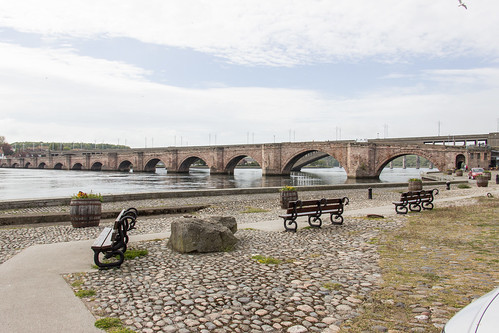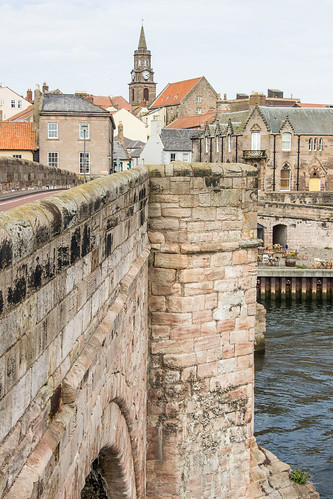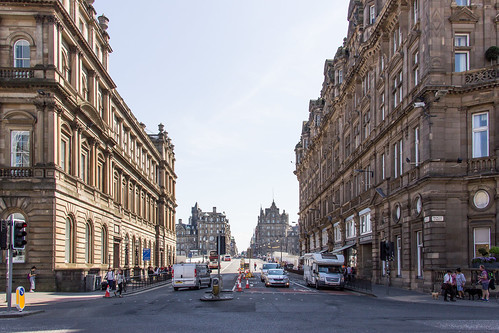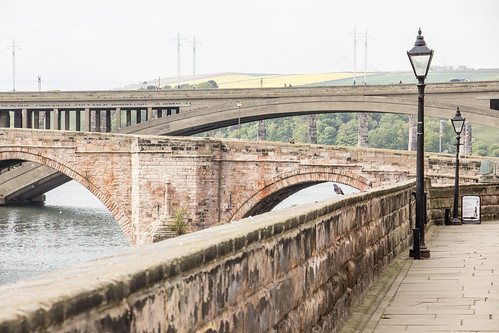Berwick Bridge, Berwick-upon-Tweed, England
Berwick Bridge, Berwick-upon-Tweed, England

Image by Billy Wilson Photography
"Berwick Bridge, also known as the Old Bridge, spans the River Tweed in Berwick-upon-Tweed, Northumberland, England. The current structure is a Grade I listed stone bridge built between 1611 and 1624.
Prior to the construction of the stone bridge, the crossing was served by a series of wooden bridges. which were variously destroyed by flooding and military action. James Burrell became Surveyor of Works of the town in 1604, making him responsible for maintenance of the bridge. He was previously also occupied on the fortifications around Berwick before James VI and I ascended the throne of England, rendering them redundant.
In 1608, ten piers of the wooden bridge were destroyed by ice, and Burrell wrote to Robert Cecil, 1st Earl of Salisbury, then Secretary of State, to recommend the construction of a stone bridge. Arrangements were made in May 1608 to collect funds, but only £3,300 had been collected by 1611, but the Captain of Berwick Sir William Bowyer was unsatisfied with this progress, and a proposal was made for a bridge with seven stone arches over the deepest part of the river and the rest built of wood. After further collapse of the old wooden bridge, a modified proposal, for an entirely stone bridge with 13 arches, and estimated to cost a further £8,462, was put to the Privy Council, and on 16 May 1611 the King ordered £8,000 to be put towards the bridge. Work started on the bridge on 19 June that year, and by September 170 men were employed on its construction. At some point it was decided to build it with 15 arches instead.
In 1618, a further £4,000 grant was given, but this money had been used by 1620 and the Privy Council placed the bridge project under the supervision of the Bishop of Durham Richard Neile before any more money was given. Neile contracted Burrell and the leading mason Lancelot Bramston to finish the bridge at a cost of £1,750, and installed John Johnson of Newcastle as supervisor. The bridge was completed by September 1621 except for the parapets and paving, but a flood in October 1621 swept away some masonry and the wooden centring. In light of the accident, a grant of £3,000 was made and work restarted the following March, and the bridge was opened to traffic in 1624, although minor work continued for the next decade.
The bridge became less important for road traffic as the main route moved westwards, first to the concrete Royal Tweed Bridge built in the 1920s, and then in the 1980s a bypass took the A1 road out of Berwick altogether.
It is a Grade I listed building and a scheduled monument.
Berwick-upon-Tweed (/ˌbɛrɪk-/; Scots: Sooth Berwick, Scottish Gaelic: Bearaig a Deas) is a town in the county of Northumberland. It is the northernmost town in England, at the mouth of the River Tweed on the east coast, 2 1⁄2 miles (4 kilometres) south of the Scottish border (the hamlet of Marshall Meadows is the actual northernmost settlement). Berwick is approximately 56 mi (90 km) east-south east of Edinburgh, 65 mi (105 km) north of Newcastle upon Tyne and 345 mi (555 km) north of London.
The 2011 United Kingdom census recorded Berwick’s population as 12,043. A civil parish and town council were created in 2008 comprising the communities of Berwick, Spittal and Tweedmouth.
Berwick was founded as an Anglo-Saxon settlement during the time of the Kingdom of Northumbria, which was annexed by England in the 10th century. The area was for more than 400 years central to historic border wars between the Kingdoms of England and Scotland, and several times possession of Berwick changed hands between the two kingdoms. The last time it changed hands was when Richard of Gloucester retook it for England in 1482. To this day many Berwickers feel a close affinity to Scotland.
Berwick remains a traditional market town and also has some notable architectural features, in particular its medieval town walls, its Georgian Town Hall, its Elizabethan ramparts, and Britain’s earliest barracks buildings, which Nicholas Hawksmoor built (1717–21) for the Board of Ordnance." – info from Wikipedia.
Summer 2019 I did a solo cycling tour across Europe through 12 countries over the course of 3 months. I began my adventure in Edinburgh, Scotland and finished in Florence, Italy cycling 8,816 km. During my trip I took 47,000 photos.
Now on Instagram.
Become a patron to my photography on Patreon.







